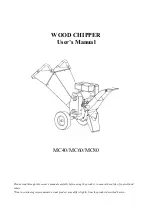
IM 1131-2
59
Troubleshooting Chart
Troubleshooting Chart
Table 41: Troubleshooting Chart
PROBLEM
POSSIBLE CAUSES
POSSIBLE CORRECTIVE STEPS
Main sw itch, circuit breakers open.
Close sw itch
Fuse blow n.
Check electrical circuits and motor w inding for shorts or grounds.
Investigate for possible overloading. Replace fuse or reset breakers
after fault is corrected.
Thermal overloads tripped or fuses blow n.
Overloads are auto reset. Check unit closely w hen unit comes back
on line.
Defective contactor or coil.
Repair or replace.
System shut dow n by equipment protection devices.
Determine type and cause of shutdow n and correct it before resetting
protection sw itch.
No cooling required.
None. Wait until unit calls for cooling.
Liquid line solenoid w ill not open.
Repair or replace coil.
Motor electrical trouble.
Check motor for opens, short circuit, or burnout.
Loose w iring.
Check all w ire junctions. Tighten all terminal screw s.
Flooding of refrigerant into crankcase.
Check superheat setting of expansion valve.
Improper piping support on suction or liquid line.
Relocate, add or remove hangers.
Worn compressor.
Replace.
Condenser w ater insufficient or temperature too high.
Readjust temperature control or w ater regulating valve. Investigate
w ays to increase w ater supply.
Fouled condenser tubes (w ater-cooled condenser). Clogged spray nozzles
(evaporative condenser). Dirty tube and fin surface (air cooled condenser).
Clean.
Noncondensables in system.
EPA purge the noncondensables.
System overcharge w ith refrigerant.
Remove excess refrigerant.
Discharge shutoff valve partially closed.
Open valve.
Condenser undersized (air-cooled).
Check condenser rating tables against the operation.
High ambient conditions.
Check condenser rating tables against the operation.
Faulty condenser temp. regulation.
Check condenser control operation.
Insufficient refrigerant in system.
Check for leaks. Repair and add charge.
Low suction pressure.
See corrective steps for low suction pressure below .
Condenser too large.
Check condenser rating table against the operation.
Low ambient conditions.
Check condenser rating tables against the operation.
Excessive load.
Reduce load or add additional equipment.
Expansion valve overfeeding.
Check remote bulb. Regulate superheat.
Lack of refrigerant.
Check for leaks. Repair and add charge.
Evaporator dirty.
Clean chemically.
Clogged liquid line filter-drier.
Replace cartridge(s).
Clogged suction line or compressor suction gas strainers.
Clean strainers.
Expansion valve malfunctioning.
Check and reset for proper superheat. Replace if necessary.
Condensing temperature too low .
Check means for regulating condensing temperature.
Compressor w ill not unload.
See corrective steps for failure of compressor to unload.
Insufficient w ater flow .
Adjust flow .
Clogged suction oil strainer.
Clean.
Excessive liquid in crankcase.
Check crankcase heater. Reset expansion valve for higher
superheat. Check liquid line solenoid valve operation.
Low oil level.
Add oil.
Flooding of refrigerant into crankcase.
Adjust thermal expansion valve.
Lack of refrigerant.
Check for leaks and repair. Add refrigerant.
Velocity in risers too low (A-C only).
Check riser sizes.
Oil trapped in line.
Check pitch of lines and refrigerant velocities.
Low voltage during high load conditions.
Check supply voltage for excessive line drop.
Defective or grounded w iring in motor or pow er circuits.
Replace compressor-motor.
Loose pow er w iring.
Check all connections and tighten.
High condensing temperature.
See corrective steps for high discharge pressure.
Pow er line fault causing unbalanced voltage.
Check Supply voltage. Notify pow er company. Do not start until fault
is corrected.
High ambient temperature around the overload relay
Provide ventilation to reduce heat.
Operating beyond design conditions.
Add facilities so that conditions are w ithin allow able limits.
Discharge valve partially shut.
Open valve.
Thermostat set too low .
Reset to 42°F (6°C) or above.
Low w ater flow .
Adjust flow .
Low suction pressure.
See “Low Suction Pressure.”
Compressor Will Not
Run
Compressor Noisy or
Vibrating
High Suction Pressure
Low Suction Pressure
High Discharge
Pressure
Low Discharge
Pressure
Motor Overload Relays
or Circuit Breakers
Open
Compressor Thermal
Sw itch Open
Freeze Protection
Opens
Little or No Oil Pressure
Compressor Loses Oil






































